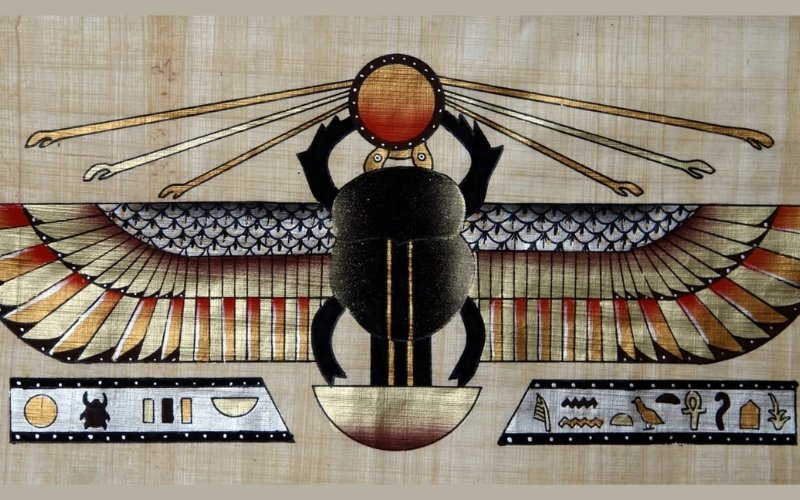Since the dawn of civilization, people have looked to animals, insects, and the natural world for guidance about life, death, and the mysteries of existence. Among the many creatures that carry symbolic weight, the scarab beetle stands out as one of the most fascinating. Most widely recognized as an ancient Egyptian emblem of protection, rebirth, and transformation, its significance goes far beyond its desert origins.
When we study the scarab closely, we find a powerful universal symbol—one that speaks of persistence, cosmic order, and the eternal cycle of renewal.
In this article, we’ll explore the scarab beetle in depth—its natural characteristics, its sacred role in Egyptian culture, its spiritual symbolism, and its lasting influence in the modern world. By the end, you’ll understand why this unassuming beetle has inspired reverence for thousands of years, from the tombs of pharaohs to contemporary spiritual practices.
What Is a Scarab Beetle?
When most people hear the word “scarab,” they imagine the polished green or blue amulets unearthed from ancient Egyptian tombs. But at its core, the scarab is a real insect: a type of dung beetle, most notably Scarabaeus sacer. Part of the large Scarabaeidae family, these beetles can be found across the globe, but the Egyptian scarab captured the ancient imagination like no other.
Physical Characteristics
Scarab beetles are usually small to medium-sized, ranging from half an inch to two inches long. They have compact, rounded bodies, and many species possess shiny or even iridescent shells in hues of green, blue, or gold. These jewel-like colors likely contributed to their association with precious stones, divine beauty, and eternal energy.
Their strong, spade-like front legs are adapted for digging and rolling—skills that became central to both their survival and the symbolic stories woven around them.
Behavior and Ecological Role
What made the scarab remarkable was its unusual behavior. These beetles feed on animal dung, shaping it into spherical balls and rolling it—sometimes backward—across long distances. To the Egyptians, this act was not mundane but cosmic. They saw in the beetle’s struggle a mirror of the sun’s daily journey across the sky, tirelessly pushed by unseen divine forces.
Beyond mythology, the scarab plays an essential role in ecosystems. By burying dung underground, these beetles fertilize the soil, recycle nutrients, and help control pests. In essence, they transform waste into life, echoing the symbolic themes of renewal, rebirth, and transformation that made them so sacred.
Life Cycle and the Mystery of Rebirth
The scarab’s reproductive cycle further deepened its mystery. Female scarabs bury their dung balls and lay eggs inside them. Weeks later, young beetles emerge from beneath the earth, seemingly born from nothing. To the ancient Egyptians, this was nothing short of miraculous—life emerging from decay, resurrection out of darkness.
This natural process became the foundation for the scarab’s symbolism as a creature of self-creation, immortality, and eternal renewal. It is why scarab amulets were placed with the dead: as guardians of the soul’s journey and reminders that death itself was only a doorway to rebirth.
Global Distribution
Although the sacred scarab is most closely linked to Egypt, scarab beetles thrive worldwide, with more than 30,000 known species. They inhabit deserts, grasslands, forests, and agricultural lands. Their resilience and adaptability mirror the qualities humans came to associate with them: persistence, survival, and the ability to thrive in any environment.
Why the Scarab Captured Egyptian Imagination
Among all insects in the arid Egyptian landscape, the scarab stood apart. Its daily struggle to push a ball many times its own weight inspired awe. Its hidden cycle of life and rebirth seemed to hold the secrets of creation. Most of all, its connection to the rising and setting sun elevated it to a cosmic emblem of order, renewal, and the eternal rhythm of existence.
The Scarab Beetle in Ancient Egyptian Culture
The Sun God Khepri
In Egyptian mythology, the scarab was sacred to Khepri, the morning manifestation of the sun god Ra. Khepri was depicted as a man with a scarab beetle for a head, endlessly pushing the sun across the sky. To the Egyptians, the scarab therefore embodied:
The daily rebirth of the sun
The creative force of the universe
Eternal renewal and transformation
Scarab Amulets and Jewelry
Scarab-shaped amulets became some of the most widespread symbols in Ancient Egypt. Crafted from stone, faience, or gold, these charms were worn as jewelry, carried as talismans, or placed in tombs. Egyptians believed scarabs had the power to:
Protect against evil and misfortune
Bring good luck and prosperity
Provide strength during life’s transitions
Ensure safe passage into the afterlife
Archaeologists often find heart scarabs in tombs, inscribed with prayers from the Book of the Dead. These were placed over the chest of the deceased to ensure that their heart would not betray them in judgment before the gods.
Seals of Authority
Scarab seals were also widely used by Egyptian officials and royalty to stamp documents. These seals symbolized not only earthly authority but also divine approval, connecting political power with cosmic order.
Symbolic Meanings of the Scarab Beetle
Over the centuries, the scarab beetle came to represent a wide range of meanings:
Rebirth and Transformation – Its life cycle made it a symbol of regeneration and new beginnings.
Immortality and Eternal Life – Just as the sun rises daily, the scarab symbolized the eternal soul.
Protection and Guidance – Worn as amulets, scarabs were believed to shield the living and guide the dead.
Strength and Persistence – Watching a scarab push a massive ball was a lesson in determination.
Cosmic Order – The beetle’s link to the sun tied it to ma’at, the principle of universal balance.
Scarab Beetle Meaning in Dreams and Spirituality
Dreams of Scarabs
Dreams involving scarabs often carry deep spiritual significance. Possible interpretations include:
A fresh start – A sign of personal growth and transformation.
Overcoming obstacles – A reminder to persevere through challenges.
Divine protection – Seen as a message of guidance from higher powers.
Modern Spiritual Practice
Today, many people view the scarab as a totem animal or spirit guide. Its message is one of courage, adaptation, and trust in life’s cycles. Meditating on the scarab can provide clarity during times of uncertainty, encouraging resilience and renewal.
Conclusion
The scarab beetle may be small, but its meaning is vast. For the Egyptians, it was a messenger of the gods, a protector in life and death, and a reminder that every sunrise brings renewal. Across time, the scarab has remained a universal symbol of transformation, resilience, and eternal life.
Even today, scarabs inspire people through art, tattoos, jewelry, and spiritual practice. They remind us that challenges can be overcome, that endings are beginnings in disguise, and that within every moment lies the potential for renewal.
From the tombs of ancient pharaohs to the modern search for meaning, the scarab continues to roll its message across the sands of time: embrace change, trust the cycles of life, and rise again with strength and light.




